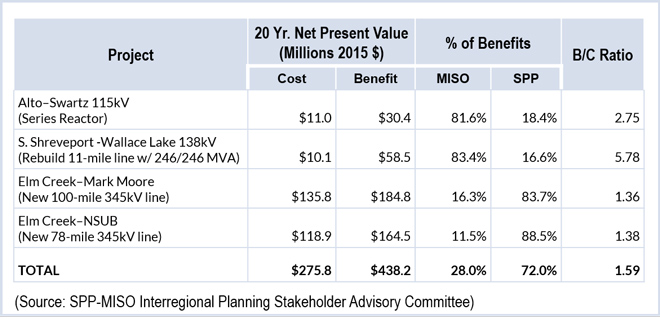By Chris O’Malley
MISO and SPP are considering $276 million in potential transmission upgrades under a joint model for identifying congested flowgates that could be relieved by economic projects.
Emerging from that joint process so far are four potential projects that could generate $438 million in benefits to the RTOs over 20 years, RTO officials said last week at a meeting of the SPP-MISO Interregional Planning Stakeholder Advisory Committee.
Four projects may not sound like much. But it’s progress considering the RTOs’ contentious relationship since December 2013 when New Orleans-based Entergy joined MISO rather than SPP, which had served as the Independent Coordinator of Transmission for Entergy’s system since 2006.
Most visible is a dispute over flows between MISO’s northern region and its new, southern region. MISO began limiting flows between the regions last spring after SPP complained that MISO had breached their joint operating agreement by moving power over its transmission footprint in excess of a 1,000-MW physical contract path.
But that dispute seemed distant as staff from both RTOs convened last week in Little Rock, Ark. Some even joked that they’ve been talking so much with those at the other RTO that they’ve memorized their phone numbers.
“We’ve learned a great deal about each other’s processes,” said Clayton Mayfield, an economic planner at SPP.
Collaboration has also improved modeling practices and provided a better understanding of neighboring stakeholder groups, said Jenell McKay, a senior analyst at MISO.
Stakeholders and staff at SPP and MISO came up with 67 potential economic projects using a joint model based on each RTO’s regional model. It projected transmission needs for 2019 and 2024.
That was whittled down to seven projects with potential, but three of those didn’t provide a minimum 5% benefit set as a threshold under the joint model.
The four projects seen to have the most potential totaled $276 million. They include new and upgraded transmission lines and transformers in Louisiana, Kansas and Nebraska. Benefits range from a 21% congestion reduction to a complete reduction in congestion.
Still Fine-Tuning List
Mayfield cautioned that the project list is preliminary and that more projects will likely emerge from the ongoing collaborative effort.
He noted that some projects initially identified were dismissed, and others added, after assumptions changed about the future of the Tennessee Valley Authority’s Shawnee units. MISO’s 2014 Transmission Expansion Plan originally contemplated that Shawnee Units 1-10, totaling 1,369 MW, would be retired, but TVA has since decided to keep nine of the Shawnee units in service.
The IPSAC joint analysis is expected to result in final project recommendations by June 30. The committee also is looking at a handful of reliability projects to reduce overloads.
More Potential
Other joint studies may be underway. McKay said the RTOs have had discussions regarding a study involving the effects of the Environmental Protection Agency’s proposed Clean Power Plan.
Pat Hayes, senior transmission policy specialist at Ameren, told the committee it could be helpful if staff conducts a “post mortem” regarding what differences the RTOs ran into and how they could have impeded a project from going through.
Kip Fox, director of transmission strategy and grid development at American Electric Power, said his “personal observation” is that the RTOs are working better together. He noted, however, that MISO and PJM have not been able to get moving on a seams project after four years. “I don’t want the same thing to happen here,” he told the committee.


